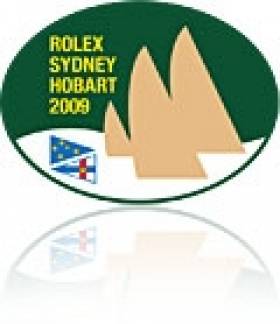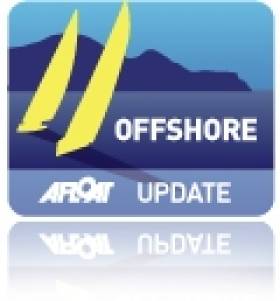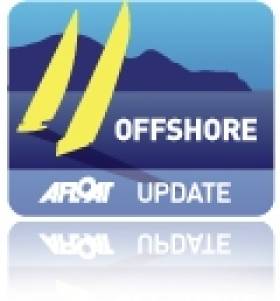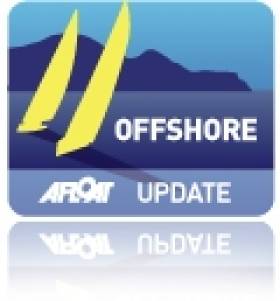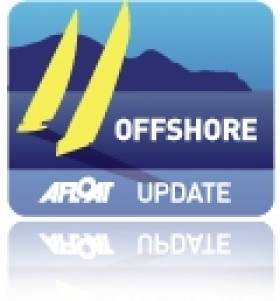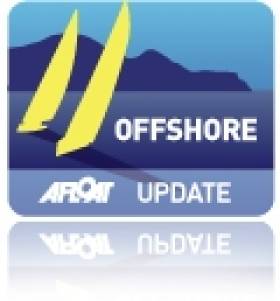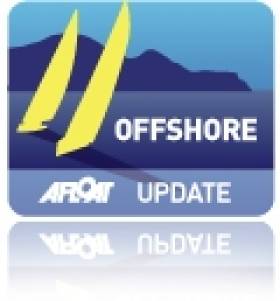Displaying items by tag: Offshore
Sir Robin Knox-Johnson Claims Third In Route Du Rhum
#RouteDuRhum - Sir Robin Knox-Johnson has surprised even himself by claiming a podium place in the Route du Rhum transatlantic offshore solo sailing challenge.
The 75-year-old sailing legend completed the more than 3,500-mile course from St Malo in Brittany to Guadeloupe in the Caribbean in less under 20 days and eight hours, taking third place in a fleet filled with world-class solo sailors.
"I didn't expect to get on the podium when I started the race," said the Clipper Round the World Race founder, as reported by the Independent.
But as he found himself towards the front of the pack, in spite of his older and heavier boat, he "got competitive and that was tiring. It came down to boat speed.
"She's a fast boat I've got," he added, referring to his 60-foot yacht with the charmingly self-deprecating name Grey Power.
The Independent has more on the story HERE.
Third Sydney–Hobart Race Beckons For Irish Offshore Sailor Barry Hurley
#rshyr – This will be my third year in a row racing 'Breakthrough' (a First 40) in the Rolex Sydney Hobart Race writes offshore sailor Barry Hurley, Afloat's October Sailor of the Month. 'Breakthrough' is a Sydney based boat owned and skippered by Mathew Vadas. He sails it with a local crew for much of the year, but I work with him remotely all year round in preparation for the Race. Come December, I normally bring some European sailors South for the event to complement the skillset of the regular crew based on experiences throughout the year. It's an arangement that works well for everybody.
Following the very stormy race last year and a busy local season, much of the boat's sail wardrobe was reaching end of life, so for this years campaign we have had the opportunity to plan a new sail inventory from scratch. We started working on this last January while last years race was fresh in our minds. By now many of the new sails have arrived and the boat is sailing regularly to gather data in different conditions which we can use to tweak the design of the last few sails in the coming weeks. We have also upgraded the standing rigging and headsail foil to reduce weight and windage up high since the majority of the competition in our class all have carbon masts and we used to suffer in heavier airs as a result. Right now we're going through all the iteratons to make sure that all the changes made actually work together, and that we haven't introduced any unexpectded weaknesses in varying conditions. So far so good though, and the boat seems to be responding as expected.
Sometimes it's the tiny little things that count however. Last year during the tough condtions crossing the Bass Straits we discovered that when the hull flexed in one particular manner it would somehow cause several of the lockers down below to open and eject their contents all over the boat. It didn't really slow us down, but it made a lot of unnessary work tidying and cleaning the inside of the boat, which was no easy task in itself in those conditions. It was a distraction, and could have caused somebody to slip and hurt themselves. Needless to say the locker catches have now all been made stormproof. My experience has taught me that it's this sort of attention to detail in boat prep that makes all the difference in an offshore race, but often the weaknesses don't show themselves until the boat gets pushed beyond it's normal routine. After crossing the Bass Strait four times on this boat we're only just getting to the stage where we feel like we're ready and fully prepared to keep pushing hard in every eventuality.

Breakthrough racing upwind in the Tasman Sea. The Tasman River and the tide play a huge role, tactics change by the hour. Photo: Rolex
Apart from the final selections which are still coming together, it is looking like three of the crew will have done two prior iterations of the race with me, and another three have completed the race once with me before now. Continuity of crew helps immensely, and just like with the boat it's only after sailing many hard miles that you really appreciate and understand everybody's individual strengths. Myself and my good friend, Ben Hunter (Australia), will manage tactics and navigation between us. Ben sails the boat regularly and is invaluable in providing feedback during the year as well as organising all the logistics of modifications as our plans evolve. The two watches will be led by Adam Carpenter (Australia) and Kenny Rumball (Dublin), both of whom are extremely talented, experienced sailors, each with the right attitude to lead a watch and keep pressing the boat through the more difficult times. One unusual aspect of this race is the enormous amount of HF radio communications mandated by the race organisers. Catherine Halpin (Dublin) will distil hours of mandatory fleet radio chatter at the chart table into a few snippets of information that can help drive tactical decisions. She will also stand watch as a bowman opposite race veteran Tom Guy (Australia). With myself, Kenny, and Adam doing most of the driving, owner Mathew Vadas will concentrate on sail trim for one watch, opposite Alexander Rumball (Dublin).
Many of the tactical decisions for the race can be made during the week in advance, with the East Australian Current (of 'Finding Nemo' fame) quite well computer modelled, and the Southern Ocean weather systems excellently forecast. This makes life easier because your inital preferred route need only be impacted by the actions of your competitors and the need for defence or offence. That said, rounding Tasman Island where the weather is volatile, the Tasman River and the tide play a huge role, and the preferred tactics change by the hour. The last day of the race, sailing up that river is often the most tactically challenging, just when physical and mental strength are running low. It is also where the race is regularly won and lost. By now I have several cheat sheets prepared and laminated, reminding me from previous experiences what to expect and where losses and gains could happen at each state of the tide on the way up the river. This makes decisions easier and quicker allowing us to keep pushing for boatspeed and concentrating on our performance againt the boats around us. I like to think that I've figured out the fast way up the river by now, but history shows that the race often comes down to a little bit of luck with the weather over that last fifty miles. It is a piece of water that throws something new at you every time you sail it, and it's never an easy day on the water.
With Mathew being in his 70th year this year, as well as it being the 70th Rolex Sydney Hobart Race, a safe arrival in Hobart will mark one of our primary goals being acheived. Having improved our performance each year to date with this boat, and having taken massive learnings each time, it's fair to say we hope to at least cause worry to those on the leaderboard in our IRC class. Due to its almost straight line trajectory, this race can sometimes favour boats at either end of the rating spectrum. Being one of the smaller boats at just 40ft, our position in the overall standings will be somewhat a result of the weather patterns during that particular week, whereas our placing within our class will be a true measure of success.
Hopefully after so much prep work in advance and the careful combination of experienced crew ready to push everything to the limit, we can hold our heads high in Hobart, priveledged to have enjoyed another classic offshore race in great company. The afterparty in Hobart on New Year's Eve will more than compensate for any hardship experienced along the way.
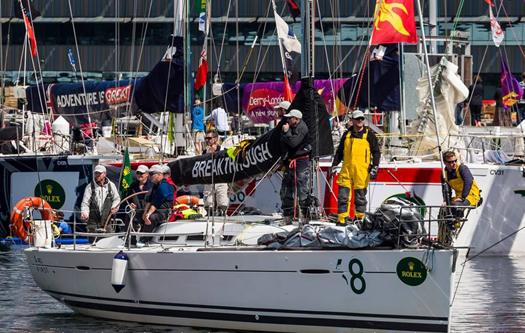
Breakthrough arrives in Hobart. Photo: Carlo Borlenghi/Rolex
#routedurhum – It has been a dramatic night with 15 incidents across the classes, including a collision between an Ultime trimaran and a cargo ship, the air rescue of a sailor after his boat lost its keel and overturned, and a Multi50 sailor who is awaiting help after his float broke off.
Thomas Coville saw his hopes of winning the Route Du Rhum vanish during the first night of the trans-Atlantic race when he damaged his yacht in a collision with a cargo ship.
Competing in the Ultimate class, the skipper of Sodebo Ultime escaped uninjured but damaged the starboard float on his boat.
Coville, who won the 3,542-nautical mile (6,560-kilometer) leg between Saint-Malo and the French Caribbean island of Guadeloupe in 1998 in the monohull class, was among the favorites for this year's race.
Another French skipper, François Angoulvant, had to be rescued after his Class 40 Team Sabrosa lost its keel. Angoulvant was airlifted to Brest where he is in good condition, according to race organisers.
Loick Peyron was leading the field early Monday aboard Banque Populaire VII.
Clipper Race chairman and founder, Sir Robin Knox-Johnston, has sent his first blog since he started Transatlantic solo race, the Route du Rhum - Destination Guadeloupe yesterday at 1400 CET from Saint-Malo, France.
With winds of 30 knots plus and large seas reported overnight, Sir Robin sent this report from his Open 60, Grey Power, this morning.
A grey sea, overcast, light drizzle and a West South Wester'ly Force 5 greeted me at dawn this morning. I am currently 40 miles from Ushant and debating whether to take the inner side of the Traffic Separation zone. Currently making 6-7 knots. Could do more if I put up more sail but we'll stay like this for the time being, as the wind is still 20 plus knots and gusting higher, just had one of 29 knots and the sea very lumpy.
It's a long race, and no point in breaking things at the beginning. I made a very cautious start. My Clipper Race colleague Simon Johnston was with me until half an hour before when my Rhum class competitor Bob Escoffier sent his rib to take him ashore. He has been invaluable, as was fellow colleague Alex Dower.
I soon found myself surrounded by 40's most of yesterday evening, pushing hard. Those boats are quick, but when the forecast squalls of 40 knots arrived I would not have wanted to be in one. Fortunately I had decided to settle in on the first night, so already had 3 reefs in the main and the storm jib set, but the boat was still pushed hard over and even with the mainsail pushed right down its track, was crashing into the waves.
I saw a couple of Automatic Identification Scheme targets turn round, I think they were in the race, but it was a gear breaking situation if you did not think of the boat and try to get her comfortable. We came through without damage, except for the staysail sheets becoming amorous, and it took a dark, cold wet hour on the foredeck, often under water, sorting out the resulting snakes' honeymoon.
Now typing this on a jumping boat is far from easy, as the computer often skips a letter or inserts one you did not ask for.
I am wondering how the big multis are fairing and if everyone is alright. There was some mention on Channel 16 last night but it was in fast spoken French.
C'est tout pour le moment.
RKJ
Solar Sail Yacht Sets Off With Route Du Rhum Fleet Tomorrow
#SolarSail - Ahead of the start of this year's Route du Rhum offshore race, UK Sailmakers gave a special preview of their state-of-the-art solar mainsail that will get its first proper sea trial on board the IMOCA 50 yacht Martinique Challenge.
As previously reported on Afloat.ie, the revolutionary new sail uses the French-designed SolarCloth System, whereby photovoltaic cells are woven into the fabric in a flexible film – allowing whatever boat hoisting it to generate power from the sun, even without direct sunlight.
The SolarCloth System has been specially designed for offshore races such as the Route du Rhum, so it will be interesting to see how the technology performs when the Martinique Challenge sets sail from Saint-Malo tomorrow with a fleet that includes an Open 60 piloted by the legendary Sir Robin Knox-Johnston.
Howth Sailors Battle The Elements In 2014 Middle Sea Race
#MiddleSeaRace - As previously reported on Afloat.ie, Irish-crewed boats made the podium in the 2014 Rolex Middle Sea Race that came to a close last week. But they didn't mark the only Irish involvement in the gruelling offshore challenge.
Howth Yacht Club was represented twice among the fleet, with one team chartering Lucy Reynolds' Beneteau First 40, Southern Child, and HYC sailor Laura Dillon setting out on the S&S 41, Winsome.
The latter was forced to retire from the race after the extreme weather conditions that hammered the Mediterranean midweek, with Dillon describing the situation as "frightening" – though both boat and crew were able to shelter at the Italian island of Pantelleria, relatively unscathed.
Meanwhile, the crew of Southern Child elected to push on to the finish, helped by their more remote location out of the full impact of the Force 10 gales that rammed the fleet.
Despite that fortune, the return leg was heavy going in confused seas and waves as high as 10 metres, and it was only on crossing the finish line that the crew discovered they'd placed sixth in Class 4, which saw 75% of entered boats retire.
"Sustained wind strengths of 44 knots for a period of 24 hours really tested the spirit of the crew, and the relentless conditions were some of the most difficult that I've seen," said HYC's Kieran Jameson, who crewed Southern Child with Darren Wright, Colm Bermingham, Frank Dillon, Rick De Nieve, David Wright, Paul Walsh, Jonny White, Will Murray and Lucy Reynolds.
Northwest Passage Sailor Safe & Sound After Reaching Aran Islands
#Offshore - RTÉ News reports that the Canadian yachtsman slowed in his crossing of the Atlantic by last week's storm conditions has made landfall at the Aran Islands.
As previously reported on Afloat.ie, 67-year-old Erkan Gursoy had been looking forward to a pint once reaching his intended landfall at Dingle after an eventful few months solo navigating the Northwest Passage.
According to Independent.ie, his boat Altan Girl finally found its way to our shores yesterday (Sunday 26 October) after contact was lost for a short period.
The vessel was escorted by the Aran Islands RNLI to Inis Mór, having sustained minor damage in the storms.
And upon repairs, Gursoy may continue his solo voyage all the way to his native Turkey.
Northwest Passage Sailor Looking Forward To Pint In Dingle
#Offshore - Canadian sailor Erkan Gursoy, who recently navigated the Northwest Passage solo, says he's looking forward to a pint once he reaches Irish waters, as RTÉ News reports.
The 67-year-old boat builder from Vancouver is currently some 500km off the west coast in his 11m yacht Altan Girl after riding out the remnants of Hurricane Gonzalo that brought heavy winds to Ireland in recent days.
And despite the initial concerns of the Irish Coast Guard, he's "not in any difficulty" as he makes slow but steady progress across the Atlantic bound for port at Dingle.
Besides, he's faced his share of bigger challenges since setting out on his epic voyage earlier this year, such as getting stuck in Arctic ice for 10 days in July – during which time he had to fend off the advances of dangerous polar bears.
RTÉ News has more on the story HERE.
Irish Offshore Sailors On Otra Vez Take Overall Lead in Middle Sea Race
#middlesearace – At Stromboli in the Meditteranean Sea this morning, two Irish sailors part of the crew on the Maltese yacht Otra Vez are first in IRC in the 600–mile Rolex Middle Sea Race. Gatt Floridia's Maltese J/122, Otra Vez was leading the class at Stromboli after time correction and immediately headed south towards the Aeolian Islands. Onboard Otra Vez, as Afloat.ie previously reported, are Ireland's top offshore sailing duo Liam Coyne and Brian Flahive, the August winners of the Round Britain and Ireland race.
At 0900 CET Otra Vez was sailing almost two knots quicker than their Maltese rival, J/122 Artie, skippered by Lee Satariano. Andy Middleton and Ross Applebey's British Oyster 48, Scarlet Oyster has taken up the most northerly position of the class, and when passing Stromboli, the highly successful yacht was lying third in class.
By Midnight virtually the entire fleet racing in the Rolex Middle Sea Race had passed through the Straits of Messina, heading for Stromboli, the active volcano that marks the most northerly part of the 608 mile course. As high pressure moved in from the north, the area around Stromboli had virtually no gradient wind and for those yachts yet to reach Stromboli, a south flowing current has slowed proceedings even further. For the competitive offshore yacht racer, performing well in light wind is more difficult than blasting through a storm at top speed.
After two nights at sea, the crew may well be at their lowest energy level for the whole race. The rhythm of offshore life has not been established and the ever changing wind saps energy through numerous sail changes. Concentration also becomes difficult. After the excitement of the start adrenalin levels are now lower and keeping alert is not as easy. In light airs, losing focus on the helm, or on the sail trim, can be very costly and stalling the boat in little wind makes it difficult to get going again.
Half of this race takes place in the hours of darkness. When the crew are deprived of the sense of sight, spotting changes in the wind on the water becomes difficult but other senses tend to make up for this deficiency. Feeling the breeze on your cheek, sensing the heel of the boat, hearing the sails flap or the bigger wavelets tapping at the hull, these become the prime indicators. The first two days and nights of the Rolex Middle Sea race have not been about surfing down big seas with the salt spray hissing past the wheel, but racing well in light airs is a dark art, and there are plenty of magicians out there.
Analysis at 0900 CET 20th October 2014
IRC 1
At sunset on Day Two Line Honours favourite, Igor Simcic's Maxi, Esimit Europa 2, entered a transition zone in the wind and came to a virtual standstill until dawn. This allowed the duelling pair of Maxi 72s to close the gap. Niklas Zennstrom's Swedish JV72, Ran V and George Sakellaris' RP72, Shockwave are now just ten miles behind, Esimit Europa 2. Ran V is now the provisional leader of IRC 1.
IRC 2
After rounding Stromboli, a group of yachts made their intentions clear; gybing south towards the Aeolian Islands in the dead of night. Greek Farr 52, Optimum 3 Aspida, co-skippered by Periklis Livas and Nick Lazos led the way along with Paolo Semeraro's Neo 400, Neo Banks Sails and Marten 49, Moana, skippered by Christian Hamma. The Aeolian Islands are a UNESCO world heritage site but this group of yachts was not going sightseeing. The islands rise up to peaks of several hundred metres. The hot air that rises during the day, cools at night, often forming a local drainage wind. What is more, this group of yachts are the closest to the north coast of Sicily, where potentially a sea breeze may develop during today.
By complete contrast, Dmitry Samohkhin, Russian Swan 60, Petite Flamme has made a move offshore. This places the yacht above the tide, which will aid the team when gybing back towards Favignana. Also fresh winds are predicted to come from the north and if the forecast is true, Petite Flamme would get into this breeze, before the other yachts in their class.
IRC 3
This morning, the yachts racing in IRC 3 have virtually restarted the race with the majority of the yachts forming a new 'line' just after rounding Stromboli. Alessandro Narduzzi's Italian Nelson Marek 43, Il Moro di Venezia XXVII, was leading at Stromboli after time correction. Igor Katalevskiy's Russian First 44.7, High Spirit was second with Andrey Abrusov Russian First 40.7, Courrier du Coeur in third. Two yachts that have enjoyed success in the early part of the race have a difference of opinion in tactics. Italian Adria 49, Ars Una, skippered by Alberto Nunziante, has taken up the most southerly position in the class. Whilst Bastiaan de Voogd's Dutch Sydney 43, Coin Coin has taken up the most northerly position.
IRC 5
At Stromboli, Peppe Fornich's Grand Italian Grand Soleil 37, Sagola Biotrading was leading the class after time correction and was nine miles ahead of their nearest rival on the water, Christopher Spray's beautifully restored classic, Stormy Weather, which has John Brinkers on board. "We are at Stromboli and it has 'glassed out', confirmed John Brinkers. "Very frustrating as Stormy Weather had a great passage last night, we had 12 knots of wind and our water line length came into great use, putting us in a good position. However this morning all we can do is watch as the smaller lighter boats drifted past us, taking away all of the miles earned through hard work last night. There isn't much we can do at the moment, but keep our spirits up and hope that the forecast for more wind will come sooner rather than later."
Frustrating as it may be for the crews racing on the slower yachts, time is not standing still. In fact the lack of breeze should be very encouraging. The overall winner of the race is decided by the IRC rating of the yacht, which is a time correction handicap. For the yachts with lower rating, their 'clock' is ticking far slower than the high performance yachts and maybe - just maybe - the 2014 Rolex Middle Sea Race will be won overall by one of the smaller yachts in the race.
Middle Sea Race Makes Record Entry of 123 Boats
#middlesearace – A record-breaking 123 yachts from more than 20 countries will cross the starting line of the Rolex Middle Sea Race on 18 October, reflecting the international stature of this popular offshore race organised by the Royal Malta Yacht Club.
The unprecedented number of entrants – a 24 percent increase over the 99 yachts competing in 2013 – includes boats from as far away as the United States and Australia along with thirteen yachts from Malta. More than 15 boats will compete for the first time.
The Line Honours favourite is Igor Simcic's Maxi, Esimit Europa 2, skippered by multiple Olympic and America's Cup winner Jochen Schumann. The 100ft canting keel maxi has taken line honour victories in the years from 2010 – 2012, becoming only the second yacht in the history of the RMSR to take it three times in a row.
Unable to compete in last year's edition due to damage suffered on the mast on their way to the race, the crew is returning with the goal of taking line honours for an unprecedented fourth occasion.
Now in its 35th year, the Rolex Middle Sea Race (RMSR) is a fixture in the season, ranking alongside the Rolex Fastnet, Rolex Sydney–Hobart and Newport-Bermuda as a "must do" race.
"For yet another year, the Rolex Middle Sea Race has grown in the number of boats that have committed to compete in this ever popular offshore race," said Godwin Zammit, Commodore of the Royal Malta Yacht Club. "There are a number of factors which contribute to the increase in participation. Naturally, the scenic yet challenging course plays a very important role, however one must mention the renowned hospitality that our Club offers its guests, which is spoken of highly by participants, often leading competitors to sign up simply through word of mouth recommendations.
Last, but not least, is our strong connection with other Clubs and our affiliation with the Royal Ocean Racing Club."
The event's fascination is largely drawn from its alluring, 608-nautical-mile racecourse – a rigorous anti-clockwise loop around Sicily which introduces numerous "corners" that present changing and complex meteorological shifts. The route includes the deep azure waters around Sicily including the Aeolian and Egadi Islands, as well as Pantelleria and Lampedusa. One of the most stunning vistas is Stromboli, the active volcano which is a course mark. Challenging, enchanting and historic, the Rolex Middle Sea Race starts in Malta's spectacular Grand Harbour at 11am on the 18 October.
"Security and safety of both racing teams and spectators has always been imperative for us and a number of procedures have been put in place. We have worked closely with the Armed Forces of Malta and Transport Malta to ensure that only authorised vessels authorised by the Race Committee will be allowed into the Grand Harbour.
Both entities will be present on the day to ensure that all procedures are strictly adhered to on the day", said Peter Dimech, Race Committee Chair and Principle Race Officer.
Supported by Rolex since 2002, the race commences and finishes in Malta. Winners will be announced throughout the week with an award ceremony wrapping up the week-long event on 25 October.
The Royal Malta Yacht Club thanks the general public for their co-operation in ensuring that all safety instructions issued by the relevant Authorities are adhered to, in order to ensure the safety of all concerned. Moreover, boats in the vicinity of the race courses are advised to navigate with caution and to keep a sharp lookout.
Sailor Rescued From Storm-Damaged Trimaran After 12 Hours Adrift
#Offshore - A British yachtsman faced a "terrifying" ordeal after his trimaran was damaged in stormy weather, stranding him at sea some 40 miles off the Isle of Wight.
Mail Online reports on Mick Royton's struggle to keep himself afloat on the upturned hull of his vessel after it de-masted in high winds and damaged two of its three hulls striking a log.
He was able to put in a mayday call but rescuers were held back by worsening conditions at sea.
It was only by chance that a Royal Navy frigate, HMS St Albans, discovered Royton clinging to the remains of his yacht Kinetic in the early hours of yesterday morning (7 October) some 12 hours later.
Andy Sergeant, coxswain for Weymouth lifeboat coxswain Andy Sergeant, whose crew assisted in his rescue said of Royton: "He was very lucky to have been found."
Mail Online has much more on the story HERE.





























